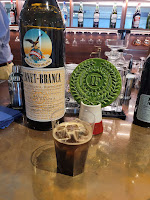
Courtesy of Tikveš Winery
Tikveš is a prominent winegrowing subregion within the Povardarie, or Vardar river valley. Tikveš the region is also readily confused with the country's largest wine producer of the same name (Tikveš winery), based in the town of Kavadartsi where the majority of vineyards in Tikveš lie. Founded in 1885 in a region with centuries-old winemaking tradition, Tikveš Winery is now celebrating 140 years of wine production.
 |
| Courtesy of Tikveš Winery |
At the embassy event, we were able to sample several wines from Tikveš Winery as well as a grape Rakija. The buffet consisted of an assortment of delicious Balkan cuisine featuring Tavče gravče, a hearty baked bean stew traditionally cooked in clay pots and seasoned with paprika, mint, and other spices. There was also Burek, grape leaves, plenty of rice and chicken, and pastries and other desserts. As for the wine, they poured a dry Cabernet Sauvignon and off-dry Vranec (Vranac) as well as a delicious dry Žilavka and off-dry Alexandria (Rhine Riesling, Chardonnay, Smederevka, Sauvignon Blanc). Here are the winery's description of the two flagship wines.
Tikveš Vranec
The name “Vranec” translates to “black stallion”, which reflects the grape’s dark color and powerful character with complex aromas. The wild nature of Vranec is tamed in this wine, characterized by a rich ruby color, a sweetish taste, full body, and a long finish. It features a myriad of aromas of ripe forest fruits, prunes, and spices
Tikveš Žilavka
Žilavka is a dry white wine with a gentle and discreet scent of flowers and fresh and fruity taste. It is made from the indigenous grape variety of the same name, derived from ‘žilav,’ meaning ‘tough’ or ‘resilient’. This reflects the grape’s ability to withstand the hot climate, drought, and poor soils. Overall, Žilavka offers a delightful combination of vivid freshness, fruitiness, and minerality, making it a great choice for those seeking a unique and enjoyable experience.






























.png)